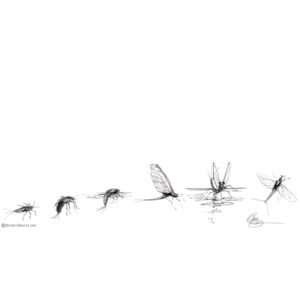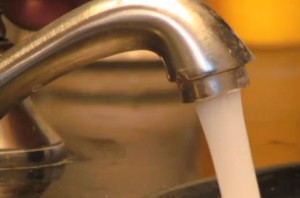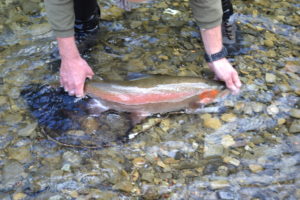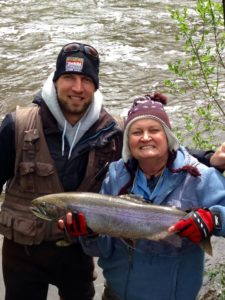Photo provided by Troutfin Studio at www.markajessop.com By: Peter Stitcher of Ascent Fly Fishing
Exhale... You've done it. You've successfully escaped the office. You've tunneled under the suburb's privacy fences, and the incessant drone cell phones and email notifications are fading into the distance behind you. In front of you lies a day without obligation and a river full of potential and the promise of hungry trout. Before you run down the trail and lose yourself on the water, slow down and PAUSE for a moment. Mother Nature has something to tell you, and listening will prove the difference between a day spent staring at the water or one punctuated with tight lines and wet hands as you release fish back into the river.
This message is a story about which bugs are hatching, what the trout are eating, and which fly patterns will give you the greatest chance of success on this water, on this day. The lines of this tale surround the river; it is recorded among the willows, whispered on the wind, and chiseled along the bed of the river. Guided by the acronym PAUSE, the fly fisher can interpret nature's cues, tie on the perfect combination of flies, and be ready for an epic day on the water.
 Parking lot to the River - Matching the hatch starts when you park the truck and continue on your way to the water's edge. While not the most appetizing script to read, plastered to your windshield and the grill of your car is a record of the bugs that were flying and hopping along the lake or river that you are planning to fish. The fragile wings of mayflies and sturdy grasshopper legs act like braille to the astute angler and are the first clues as to what flies they might fish that day. As you leave the parking lot and work your way down to the water, observe what is hopping and flying around you. Grasshoppers frantically leaping off the trail ahead of you, the wayward beetle landing on your shoulder, and the shrilling of the cicada, and caddis flies stirring into flight as you push through streamside trees are all indicators of food that might be falling or landing on the water.
Parking lot to the River - Matching the hatch starts when you park the truck and continue on your way to the water's edge. While not the most appetizing script to read, plastered to your windshield and the grill of your car is a record of the bugs that were flying and hopping along the lake or river that you are planning to fish. The fragile wings of mayflies and sturdy grasshopper legs act like braille to the astute angler and are the first clues as to what flies they might fish that day. As you leave the parking lot and work your way down to the water, observe what is hopping and flying around you. Grasshoppers frantically leaping off the trail ahead of you, the wayward beetle landing on your shoulder, and the shrilling of the cicada, and caddis flies stirring into flight as you push through streamside trees are all indicators of food that might be falling or landing on the water.
Above the Water- Swallows flying and swooping over the water are going to be your first indicator that bugs are hatching from the water and dry flies might be on the menu! As you reach the water's edge, watch for swarms of invertebrates over the water and streamside vegetation. Even at a distance, the chaotic flight of the caddis, the purposeful straightforward flight of the stonefly, and the orderly wave-like motion of the mayfly will be evident, and will help to direct you to the most likely dry flies in your fly box.
 Under the Water - It is beneath the surface of the water that trout do 75% of their feeding, and that's where the angler's most important information will be found. Using an Invertebrate Seine along the streambed and pulling rocks from the current to observe what is holding onto their surface will give you a detailed menu of which bugs are most abundant, as well as their size and color so that you can lay your fly box alongside and choose the closest match.
Under the Water - It is beneath the surface of the water that trout do 75% of their feeding, and that's where the angler's most important information will be found. Using an Invertebrate Seine along the streambed and pulling rocks from the current to observe what is holding onto their surface will give you a detailed menu of which bugs are most abundant, as well as their size and color so that you can lay your fly box alongside and choose the closest match.
Spider Webs - Spiders are Mother Nature's PhD level Entomologists and are the most efficient samplers of insects along the river. If it has been hatching or hopping along the water where you are fishing, the spiders will have caught them. Look for spider webs in the bushes and snags along the river and hold your fly box up to their latest catch to match the hatch.
Eddies - Like the Bermuda Triangle of Trout, swirling currents and backwaters along the edge of the river provide a catalog of the most active bugs in and on the water. Spinning on top of the rotating current will be a sample of spent invertebrate cases, crippled insects, and expired post-spawn adults. Beneath the surface of the water, the same currents that trapped the adults in their dizzying spin also act to deliver aquatic insects to these collection points where they can be easily observed and matched by the angler.
Success never comes easily for the fly fisherman. There is no such thing as a lucky fly that will produce every trip to the river, and there are no infallible guides equipped with crystal balls through which to foresee the next hatch. However, for the fly fisher who takes a moment to PAUSE and observe, the rewards will be immediate, the fish will be more frequent, and the experience on the water will be that much richer!

Peter Stitcher is an Aquatic Biologist and the Chief Fly Geek at Ascent Fly Fishing. At Ascent we don't guess what the fish are biting on, we know! With our Biologist Crafted Fly Selections you can tell us where you are fishing, when you are fishing, your budget, and skill level, and we will match down to the life cycle to the fly what the fish will be eating when you are on the water! You can see our full spread of flies and gear, and read our Sci-Fly Fishing Blog at: WWW.ASCENTFLYFISHING.COM
Ascent Fly Fishing is also a proud Trout Unlimited Business partner, and have provided free TU memberships to more than 1000 of our clients in the last two years.






 Recycle water:
Recycle water: Growing up on the dirt roads just east of Parker, Colorado, I was fortunate enough to explore the many streams and lakes that this great state has to offer. In particular, I often found myself hiking up small creeks in the Gunnison Basin in search for the pockets of eagerly-feeding brookies that never once questioned my poor presentation or choice of fly. By the time I was twelve years old, I had my own fly rod and I was hooked.
Growing up on the dirt roads just east of Parker, Colorado, I was fortunate enough to explore the many streams and lakes that this great state has to offer. In particular, I often found myself hiking up small creeks in the Gunnison Basin in search for the pockets of eagerly-feeding brookies that never once questioned my poor presentation or choice of fly. By the time I was twelve years old, I had my own fly rod and I was hooked. After moving back to Gunnison in 2013, I worked with a team of fellow raft guides and conservationists to start a non-profit rafting company. River Restoration Adventures for Tomorrow (RRAFT) is a small outfitter dedicated to protecting critical watersheds through community engagement and hands-on restoration work. Over the past three seasons, our team has worked with over 400 community volunteers and youth to conduct various conservation projects on over 300 miles of riparian corridor throughout Colorado and Utah. Our trips ranged from cottonwood planting projects with Delta and Cedaredge High School youth, to overnight trips with the Adaptive Sports Center and Peace of Adventure, to 10-day surveys of invasive plant species along the Colorado River in Cataract Canyon with the National Park Service and the Southwest Conservation Corps Ancestral Lands crews. Not only were we making a difference for the rivers, we were helping to inspire and engage the next generation of stewards.
After moving back to Gunnison in 2013, I worked with a team of fellow raft guides and conservationists to start a non-profit rafting company. River Restoration Adventures for Tomorrow (RRAFT) is a small outfitter dedicated to protecting critical watersheds through community engagement and hands-on restoration work. Over the past three seasons, our team has worked with over 400 community volunteers and youth to conduct various conservation projects on over 300 miles of riparian corridor throughout Colorado and Utah. Our trips ranged from cottonwood planting projects with Delta and Cedaredge High School youth, to overnight trips with the Adaptive Sports Center and Peace of Adventure, to 10-day surveys of invasive plant species along the Colorado River in Cataract Canyon with the National Park Service and the Southwest Conservation Corps Ancestral Lands crews. Not only were we making a difference for the rivers, we were helping to inspire and engage the next generation of stewards. After moving South in the early 1990s I transferred to the Southern Colorado Greenback Chapter of TU. After several years, I was on the Board again, serving mainly in the capacity of Communications Chairman. I will be retiring this year, but plan on maintaining an active role in the chapter. Hubby Paul and I are Life Members, and proud of that.
After moving South in the early 1990s I transferred to the Southern Colorado Greenback Chapter of TU. After several years, I was on the Board again, serving mainly in the capacity of Communications Chairman. I will be retiring this year, but plan on maintaining an active role in the chapter. Hubby Paul and I are Life Members, and proud of that. Kids’ education. Several years ago, Jenny Kedward from the local Sierra Club, Pat McGraw, then-President of our Chapter, and I collaborated to do a two-day summer camp program for 12-14 year olds in our community that concentrated on water education and fishing. We conducted it for four years in a row. Our chapter’s Frostbite Fish-Off Tourney, held for several years, is a close second.
Kids’ education. Several years ago, Jenny Kedward from the local Sierra Club, Pat McGraw, then-President of our Chapter, and I collaborated to do a two-day summer camp program for 12-14 year olds in our community that concentrated on water education and fishing. We conducted it for four years in a row. Our chapter’s Frostbite Fish-Off Tourney, held for several years, is a close second. But there is one scenario where tenkara rods really shine, and that is for winter tailwater fishing. Colorado is home to many productive winter fisheries, most located below big dams. Tailwaters include the Blue River below Dillon Reservoir, the Frying Pan below Ruedi, the Yampa below Stagecoach, and the Taylor, to name a few. What these waters have in common is a steady flow of (relatively) warm water flowing all winter that is conducive to insect hatches, and in turn to feeding fish. Waters like this are justifiably famous for the big trout they produce, but fishing them during the high season usually means casting right beside many others doing the same thing. The nice thing about visiting them in the winter when everyone else is on the slopes, or inside nice and warm and dreaming of April, is that you can often have these normally busy waters all to yourself.
But there is one scenario where tenkara rods really shine, and that is for winter tailwater fishing. Colorado is home to many productive winter fisheries, most located below big dams. Tailwaters include the Blue River below Dillon Reservoir, the Frying Pan below Ruedi, the Yampa below Stagecoach, and the Taylor, to name a few. What these waters have in common is a steady flow of (relatively) warm water flowing all winter that is conducive to insect hatches, and in turn to feeding fish. Waters like this are justifiably famous for the big trout they produce, but fishing them during the high season usually means casting right beside many others doing the same thing. The nice thing about visiting them in the winter when everyone else is on the slopes, or inside nice and warm and dreaming of April, is that you can often have these normally busy waters all to yourself.
